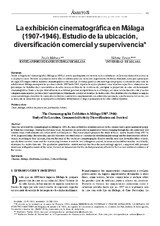Mostrar el registro sencillo del ítem
La exhibición cinematográfica en Málaga (1907-1946). Estudio de la ubicación, diversificación comercial y supervivencia
| dc.contributor.author | Meliveo, Paula | |
| dc.contributor.author | Parejo, Nekane | |
| dc.date.accessioned | 2022-02-21T10:46:25Z | |
| dc.date.available | 2022-02-21T10:46:25Z | |
| dc.date.issued | 2021 | |
| dc.identifier.issn | 1575-2100 | |
| dc.identifier.issn | 2386-4494 | |
| dc.identifier.uri | http://hdl.handle.net/10396/22545 | |
| dc.description.abstract | Desde la llegada del cinematógrafo a Málaga en 1898, el interés que despierta este invento en los ciudadanos conlleva una destacable asistencia a las proyecciones. Durante los primeros nueve años se exhiben películas en locales improvisados de forma itinerante, hasta que a principios del siglo XX surgen establecimientos cinematográficos con sede fija. De forma genérica esta investigación propone el estudio de estas salas de exhibición en Málaga en un período que abarca desde 1907 hasta 1946. A partir de aquí se plantean como objetivos específicos: determinar los porcentajes de distribución y características de estos locales en función de su ubicación, averiguar la proporción de salas exclusivamente cinematográficas frente a las que diversificaron su actividad, precisar su supervivencia en el tiempo, así como la relación entre ésta y las dos categorías mencionadas, la ubicación y la polivalencia y finalmente, establecer su índice de destrucción. Para abordar estas cuestiones se emplea como metodología el análisis de contenido cualitativo-cuantitativo complementado con entrevistas personales a profesionales del sector, con la intención de demostrar que los parámetros estudiados influyeron en el auge y permanencia de estos establecimientos. | es_ES |
| dc.description.abstract | Since the arrival of the cinematograph in Málaga in 1898, the interest that this invention arouses in the citizens took a great amount of people to watch the screenings. During the first nine years, the movies are proyected in improvised venues roaming thorugh the city, until early XX century some establishments are settled down in fixed places. This researchment purposes the study of these movie theatres from 1907 to 1946, in general terms. Based on this, specific objectives are stated such as: calculate the distribution percentage and the characteristics of these venues according to their location, find out the ratio of the exclusive cinematographic theatres and the ones that diversified their activity, specify their survival years and the relationship between it and the two cathegories quoted, location and multifunctionality. And finally, determine the destruction rate. The qualitative-quantitative content analisys has been the methodology applied, completed with personal interviews with professionals of the sector, focused on demonstrate that the studied parameters affected to the rise and continued existence of the venues. | es_ES |
| dc.format.mimetype | application/pdf | es_ES |
| dc.language.iso | spa | es_ES |
| dc.publisher | Asociación de Estudios de Ciencias Sociales y Humanidades | es_ES |
| dc.rights | https://creativecommons.org/licenses/by-nc-nd/4.0/ | es_ES |
| dc.source | Ámbitos 46, 41-58 (2021) | es_ES |
| dc.subject | Cines | es_ES |
| dc.subject | Exhibición | es_ES |
| dc.subject | Ubicación | es_ES |
| dc.subject | Patrimonio cultural | es_ES |
| dc.subject | Málaga (España) | es_ES |
| dc.subject | Cimenas | es_ES |
| dc.subject | Exhibition | es_ES |
| dc.subject | Location | es_ES |
| dc.subject | Cultural heritage | es_ES |
| dc.title | La exhibición cinematográfica en Málaga (1907-1946). Estudio de la ubicación, diversificación comercial y supervivencia | es_ES |
| dc.title.alternative | The Cinematographic Exhibition in Málaga (1907-1946): Study of the Location, Commercial Activity Diversification and Survival | es_ES |
| dc.type | info:eu-repo/semantics/article | es_ES |
| dc.rights.accessRights | info:eu-repo/semantics/openAccess | es_ES |

